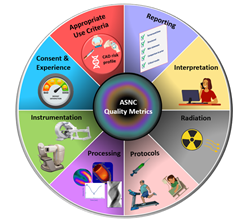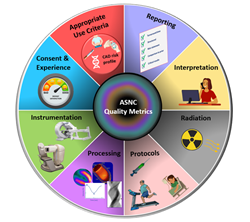[ad_1]

ASNC Quality Metrics
The ultimate goal is to put the patient first and improve the quality of imaging services and experience. These metrics should serve as a cornerstone of continuous quality improvement in nuclear cardiology labs. – Andrew J. Einstein, MD, PhD, MASNC
FAIRFAX, Va. (PRWEB)
January 10, 2023
Nuclear stress testing performed with single-photon emission computed tomography (SPECT) is the most commonly performed cardiac imaging test in the U.S. The test has been the focus of many practice guidelines, appropriate use criteria, practice standards statements, and laboratory accreditation requirements. Now, a new resource developed by the American Society of Nuclear Cardiology (ASNC) harmonizes the recommendations and provides SPECT myocardial perfusion imagers with a comprehensive blueprint for tackling quality improvement in their laboratories and measuring their impact on patient care.
Published online in the Journal of Nuclear Cardiology, Quality Metrics for Single-photon Emission Computed Tomography Myocardial Perfusion Imaging: An ASNC Information Statement cuts through the challenges practitioners may experience with the volume of prior recommendations by providing eight quality axes that capture the most important aspects of SPECT MPI performance.
Each axis is broken down into a series of measurable metrics that, together with the worksheet templates provided with the new statement, make it easy for nuclear cardiology teams to assess specific areas where their laboratories are deficient, set targets to achieve in defined time periods, and continually reassess their progress.
“The key to quality improvement is selecting a specific target and getting started. With the introduction of these quality metrics, ASNC is providing cardiac imaging professionals with tools that will help us assess and select appropriate target metrics to achieve measurable improvement on the quality of care for our patients,” says Fadi G. Hage, MD, MASNC, director of nuclear cardiology at the University of Alabama at Birmingham, chief of cardiology at the Birmingham VA medical center and chair of the document’s writing committee.
ASNC’s quality metrics information statement is a result of efforts by a vast network of experts from across nuclear cardiology who not only designed the quality metrics to be useable and impactful for labs but also ensured the cardiac imaging community was engaged in the process. The quality metrics were beta-tested in eight nuclear cardiology labs and made available to ASNC members, who provided feedback online and during a special session at ASNC’s 2022 Annual Scientific Session and Exhibition.
“This document will provide every lab that performs SPECT MPI with multiple opportunities to perform self-assessment across eight axes of practice and identify possibilities for improvement,” says Andrew J. Einstein, MD, PhD, MASNC, director of nuclear cardiology, cardiac CT, and cardiac MRI at Columbia University Irving Medical Center/NewYork-Presbyterian Hospital and co-chair of the document’s writing committee. “The ultimate goal is to put the patient first and improve the quality of imaging services and experience. These metrics should serve as a cornerstone of continuous quality improvement in nuclear cardiology labs.”
Quality Metrics for Single-photon Emission Computed Tomography Myocardial Perfusion Imaging: An ASNC Information Statement is available for download from the Journal of Nuclear Cardiology.
The writing committee chair and co-chair are available for interviews.
###
About the American Society of Nuclear Cardiology
Now in its 30th year, the American Society of Nuclear Cardiology and its more than 4,900 members have been improving cardiovascular outcomes through image-guided patient management. As the only society dedicated solely to the field of nuclear cardiology, ASNC establishes standards for excellence in cardiovascular imaging through the development of clinical guidelines, professional medical education, advocacy and research development. ASNC provides peer-reviewed original articles through its official publication Journal of Nuclear Cardiology and operates the nation’s first noninvasive cardiac imaging registry, ImageGuide Registry®, to benchmark quality and improve patient care. For more information, visit http://www.asnc.org.
Share article on social media or email:
[ad_2]

